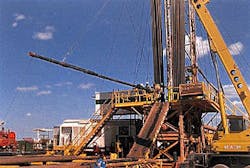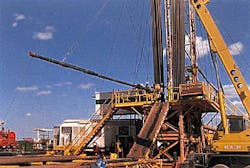An onshore injection well, in Brazil, is the site of an all-electronic, multizone intelligent well completion being tested for eventual use by Petroleo Brasileiro SA (Petrobras) in its deepwater Campos basin wells. The joint Baker Oil Tools and Petrobras testing-qualification program focuses on live-well demonstration of functional compliance, reliability, and fitness-for-use.
Baker Oil Tools installed the equipment in the Varginha 8-VRG-8RN well on May 22, 2001 (Fig. 1).
The Baker Oil Tools InCharge system's design allows an operator to optimize flow from critical wells without shutting in production or performing costly intervention work. The system monitors pressure, temperature, and flow conditions at the sandface in real time, thereby enabling selective control of individual zonal flow rates in response to changing downhole conditions.
Downhole equipment
Baker Oil Tools says one aspect of its system that is particularly valuable to subsea operators is that a single control line penetrates packers and wellhead. From this control line, the operator can monitor and control up to 12 zones in a single well and up to 12 wells from a single control system.
The system incorporates an electric downhole wet-disconnect anchor that Baker Oil Tools claims to be the world's first such system. It says this disconnect eases maintenance and repair in the upper portion of the completion string through an electric umbilical to the surface that can be repeatedly disconnected and reconnected.
As discussed in a presentation at last week's Deep Offshore Technology (DOT) Conference in Rio de Janeiro, the main equipment run in the test well included:
- A 51/2-in. by 20 ft expansion joint, non-separating and capable of pre-spaced positioning.
- Electromechanical downhole disconnect-reconnect device.
- A 95/8 by 51/2-in. packer compatible with system.
- Adjustable 51/2-in. choke with integrated position sensor, and internal and external pressure-temperature sensors.
- A 51/2-in. venturi flow meter for single-phase flow.
- Adjustable 31/2-in. choke (shrouded) with integrated position sensor, and internal and external pressure-temperature sensors.
- A 31/2-in. venturi flow meter for single-phase flow.
- A 1/4-in. OD tubing encapsulated conductor (TEC) with 11 by 11 mm encapsulation.
- TEC protection system.
- Subsea wet electrical connectors.
Real-time measurement, actuator control
The DOT conference presentation explained that from a process control perspective, the intelligent completion system is a real-time network, consisting of a master surface control system monitoring and controlling four downhole nodes over a simple two-conductor bus, using a proprietary power-on-commands technique.
The operator interacts with the intelligent well system via a graphical user interface running on the personal computer of the surface control system. The computer operates in conjunction with the wellhead interface unit to provide power to and communications with the downhole network.
Each of the four active downhole components (nodes) is selectively addressable and continuously delivers multiple data parameters at a sampling rate of up to one per second for all sensors.



